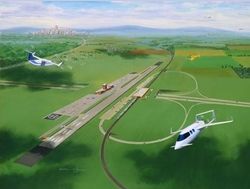Wed, Aug 04, 2004
NASA To Show Off Small Aircraft Transport System
 NASA/Langley's Dr. Victor Lebacqz,
Associate Administrator for Aeronautics plans to put it all on the
line about 10 months from now. He's scheduled a flight
demonstration of SATS technology June 5, 2005. The three day event
will be held in Danville (VA) at the Danville Regional Airport.
NASA/Langley's Dr. Victor Lebacqz,
Associate Administrator for Aeronautics plans to put it all on the
line about 10 months from now. He's scheduled a flight
demonstration of SATS technology June 5, 2005. The three day event
will be held in Danville (VA) at the Danville Regional Airport.
From the SATS program literature; "The long-term vision is to
enable a safe travel alternative that will free people and products
from the constraints of today's ground and air transportation
systems. SATS is conceived to enable equitable, on demand, widely
distributed access to more communities in less time."
The technology being developed and integrated in SATS includes:
Flight Path Management, Flight Deck Technologies,
Communication/Navigation/Surveillance, Flight Test Operations,
Aircraft, Airspace and Demonstration Integration.
Four key operating capabilities are designed to create access to
virtually all runways in the nation. First, separation and
sequencing of multiple aircraft without use of traditional
ground-based terminal radar and communication systems. Second,
Safer aircraft takeoff and landing operations in poor weather at
minimally equipped airports, minimizing land use impacts. Third,
improved single-pilot performance for safety, accuracy and ease of
use. Last, the integration of larger numbers of small aircraft into
the national airspace system. All of these capabilities are
accomplished without control towers or ground-based navigation and
lighting systems.

What does that mean to the average pilot? If the program is
successful and is able to be implemented affordably and in a
reasonably short period of time, Pilots will be able to fly from
departure to destination from thousands of local airport without
the use of traditional radar based air traffic control.
So if you want to see what has been achieved with the SATS
programs 30+ million dollar per year budget (31.7 million for
fiscal year 2004), Danville is the place to be June 5-7, 2005.
More News
Aero Linx: Model Aeronautical Association of Australia MAAA clubs are about fun flying, camaraderie and community. For over 75 years, the MAAA has been Australia’s largest fl>[...]
Touchdown Zone Lighting Two rows of transverse light bars located symmetrically about the runway centerline normally at 100 foot intervals. The basic system extends 3,000 feet alon>[...]
“Discovery and innovation are central to our mission at Virgin Galactic. We’re excited to build on our successful record of facilitating scientific experiments in subor>[...]
How To Get A Story On Aero-TV News/Feature Programming How do I submit a story idea or lead to Aero-TV? If you would like to submit a story idea or lead, please contact Jim Campbel>[...]
Student Pilot Reported That During Rotation, “All Of A Sudden The Back Of The Plane Kicked To The Right..." Analysis: The student pilot reported that during rotation, “>[...]
 ANN's Daily Aero-Linx (05.02.24)
ANN's Daily Aero-Linx (05.02.24) ANN's Daily Aero-Term (05.02.24): Touchdown Zone Lighting
ANN's Daily Aero-Term (05.02.24): Touchdown Zone Lighting Aero-News: Quote of the Day (05.02.24)
Aero-News: Quote of the Day (05.02.24) ANN FAQ: Contributing To Aero-TV
ANN FAQ: Contributing To Aero-TV NTSB Final Report: Cirrus Design Corp SR20
NTSB Final Report: Cirrus Design Corp SR20




